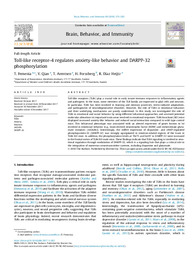Please use this identifier to cite or link to this item:
https://hdl.handle.net/11000/35426Full metadata record
| DC Field | Value | Language |
|---|---|---|
| dc.contributor.author | FEMENIA CANTO, TERESA | - |
| dc.contributor.author | Qian, Y. | - |
| dc.contributor.author | Arentsen, T. | - |
| dc.contributor.author | Forssberg, H. | - |
| dc.contributor.author | Diaz Heijtz, Rochellys | - |
| dc.contributor.other | Departamentos de la UMH::Farmacología, Pediatría y Química Orgánica | es_ES |
| dc.date.accessioned | 2025-01-28T18:34:00Z | - |
| dc.date.available | 2025-01-28T18:34:00Z | - |
| dc.date.created | 2018 | - |
| dc.identifier.citation | Brain, Behavior, and Immunity. 2018 Mar:69:273-282 | es_ES |
| dc.identifier.issn | 1090-2139 | - |
| dc.identifier.issn | 0889-1591 | - |
| dc.identifier.uri | https://hdl.handle.net/11000/35426 | - |
| dc.description.abstract | Toll-like receptors (TLRs) play a crucial role in early innate immune responses to inflammatory agents and pathogens. In the brain, some members of the TLR family are expressed in glial cells and neurons. In particular, TLR4 has been involved in learning and memory processes, stress-induced adaptations, and pathogenesis of neurodegenerative disorders. However, the role of TLR4 in emotional behaviors and their underlying mechanisms are poorly understood. In this study, we investigated the role of TLR4 in emotional and social behavior by using different behavioral approaches, and assessed potential molecular alterations in important brain areas involved in emotional responses. TLR4 knockout (KO) mice displayed increased anxiety-like behavior and reduced social interaction compared to wild type control mice. This behavioral phenotype was associated with an altered expression of genes known to be involved in emotional behavior [e.g., brain-derived neurotrophic factor (BDNF) and metabotropic glutamate receptors (mGluRs)]. Interestingly, the mRNA expression of dopamine- and cAMP-regulated phosphoprotein-32 (DARPP-32) was strongly upregulated in emotion-related regions of the brain in TLR4 KO mice. In addition, the phosphorylation levels at Thr75 and Ser97 in DARPP-32 were increased in the frontal cortex of TLR4 KO male mice. These findings indicate that TLR4 signaling is involved in emotional regulation through modulation of DARPP-32, which is a signaling hub that plays a critical role in the integration of numerous neurotransmitter systems, including dopamine and glutamate. | es_ES |
| dc.format | application/pdf | es_ES |
| dc.format.extent | 10 | es_ES |
| dc.language.iso | eng | es_ES |
| dc.publisher | Elsevier | es_ES |
| dc.rights | info:eu-repo/semantics/openAccess | es_ES |
| dc.rights.uri | http://creativecommons.org/licenses/by-nc-nd/4.0/ | * |
| dc.subject | TLR4 | es_ES |
| dc.subject | Anxiety | es_ES |
| dc.subject | Emotion | es_ES |
| dc.subject | mGluRs | es_ES |
| dc.subject | DARPP-32 | es_ES |
| dc.title | Toll-like receptor-4 regulates anxiety-like behavior and DARPP-32 phosphorylation | es_ES |
| dc.type | info:eu-repo/semantics/article | es_ES |
| dc.relation.publisherversion | https://doi.org/10.1016/j.bbi.2017.11.022 | es_ES |

View/Open:
Toll-like receptor-4 regulates anxiety-like behavior and DARPP-32 phosphorylation.pdf
1,92 MB
Adobe PDF
Share:
.png)
